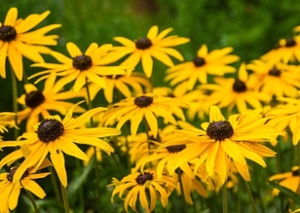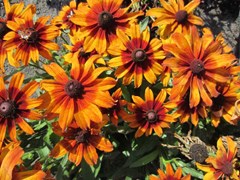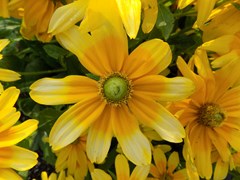Rudbeckia hirta: Black Eyed Susan
Latin name: Rudbeckia hirta
Common name: Black Eyed Susan
Flowers: Gold, yellow. spring, summer 13
Fruit: Inconspicuous 4
Height & Width: 1-3’ tall 10 1-2’ wide 12
Type: Herbaceous perennial 4
Habit: Erect, open 13
Wetland indicator category**: FACU 17
Texture: Coarse 10
Growth rate: Medium/average 4
Light: Full sun 12
Moisture: Moist organic, well drained. Drought tolerant once established 4,10
Soil*: 6-8 13
Zones: 3-7 12
Origin: Native to U.S lower 48 16
Ecosystem benefits: It is a larval host plant to Wavy-lined Emerald (Synchlora aerata) and to Silvery Checkerspot (Chlosyne nycteis) Flowers and seeds attract pollinators such as bees and butterflies. Seeds also attract birds, such as American goldfinches 4



Features: Black Eyed Susans show desirable bright yellow and golden flowers during the spring and summer months. They also attract many different types of pollinators and wildlife such as birds 4.
Siting: This species can be planted in open meadows or in mass planting groups. It prefers moist, well-drained soil and full sun, but can tolerate partial shade 4,12.
Care: Plant crown at soil level 18. At planting, water the roots and surrounding area slowly and deeply. Keep soil moist until plant is established, then apply enough water to thoroughly moisten the root zone when the soil is dry or during drought. Modify water recommendations to reflect site drainage and rainfall. Apply 3” of mulch over the planted area. Do not allow mulch to touch the plant stems 18. Moderate fertility will give you the best flower show so avoid the edges of lawns where lawn fertilizer will provide excess nitrogen 4.
Pests: Note that this plant is moderately deer resistant. Plants are relatively pest resistant if cultural preferences are met 4.
Recommended cultivars: 'Cherry Brandy' – 21-24 in, dark red bloom, early summer to mid-fall, cold hardy, drought and heat tolerant, prefers well drained organic soil, resistant to pests and deer 12.
'Prairie Sun' – 30-36 in, orange rays tipped with lemon yellow and green colored center disks, early summer to mid-fall, cold hardy, drought and heat tolerant, likes well drained organic soil, pest and deer resistant 12.
'Autumn Colors' – 18-24 in, bicolor with shades of yellow, orange, red and brown cone, early summer to mid-fall, cold hardy, drought and heat tolerant, prefers well drained organic soil, resistant to pests and deer 12.
'Indian Summer' – 24-36 in, bright yellow rays with purple/brown center disks, early summer to mid-fall, cold hardy, drought and heat tolerant, prefers well drained organic soil, resistant to pests and deer 12.
This plant does not appear on the following invasive plant lists on (3-1-21):
- USDA SC Invasive Plant Species Web site at http://www.invasivespeciesinfo.gov/plants/main.shtml
- SC Exotic Plant Pest Council Web site at http://www.se-eppc.org/southcarolina/
Author: Parker Calvert
Image source:
1) https://www.clemson.edu/extension/carolinayards/plant-database/index.html#cypdb/details/52ee9eb1740e8cad593e5217/
2) https://garden.org/plants/photo/484385/
3) https://images.mobot.org/PlantRecords1/prod/small240/00103000/103690.JPG
Sources:
- Armitage, A. (2001). Armitage’s manual of annuals, biennials, and half-hardy perennials. Portland, OR: Timber Press.
- Armitage, A. (2006). Armitage’s native plants for North American gardens. Portland, Oregon: Timber Press.
- Armitage, A. (2008). Herbaceous perennial plants: A treatise on their identification, culture, and garden attributes. Athens, GA: University of Georgia.
- Clemson Cooperative Extension Home and Garden Information Center.(2011). Flowers fact sheets. Retrieved from https://hgic.clemson.edu/category/flowers/
- Clemson Cooperative Extension Home and Garden Information Center.(2011). Groundcovers & vines fact sheets. Retrieved from https://hgic.clemson.edu/category/groundcovers/
- Clemson Cooperative Extension Home and Garden Information Center.(2011). Trees. Retrieved from https://hgic.clemson.edu/category/trees/
- Clemson Cooperative Extension Home and Garden Information Center.(2011). Shrubs. Retrieved from https://hgic.clemson.edu/category/shrubs/
- Dirr, M. A. (2009). Manual of woody landscape plants. Champaign, IL: Stipes Publishing.
- Gilman, E. F. (1997). Trees for urban and suburban landscapes. Albany, NY: Delmar Publishers.
- Lady Bird Johnson Wildflower Center University of Texas at Austin. (2012). Native plant information network. Retrieved from http://www.wildflower.org/explore/
- McMillan, P., Plant taxonomist Clemson University, personal communication.
- Missouri Botanical Garden Kemper Center for Home Gardening. Plant finder. Retrieved from http://www.mobot.org/gardeninghelp/plantfinder/Alpha.asp
- North Carolina State University (2005). Plant fact sheets. Retrieved from http://www.ces.ncsu.edu/depts/hort/consumer/factsheets/index.html
- Strother, E. V., Ham, D. L., Gilland, L. (2003) Urban tree species guide: Choosing the right tree for the right place. Columbia, SC: South Carolina Forestry Commission.
- University of Florida, IFAS Extension. (2011). Southern trees fact sheet. Retrieved from http://edis.ifas.ufl.edu/department_envhort-trees
- USDA . Plant profile. (n/d).Retrieved from http://plants.usda.gov/java/
- USDA. Plant wetland indicator status. (n/d). Retrieved from http://plants.usda.gov/wetland.html
- Vincent, E., Environmental horticulturist Clemson University, personal communication.
- Clemson Extension. Carolina Yards Plant Database. Retrieved from https://www.clemson.edu/extension/carolinayards/plant-database/index.html
*Soil pH is determined using a professional soil test. Contact your Clemson University County Extension service for assistance www.clemson.edu/extension/. Click on “local offices”.
**2012 Plant Wetland Indicator categories (quantitative derived) http://plants.usda.gov/wetinfo.html
|
Indicator Code |
Indicator Status |
Comment |
|
OBL |
Obligate Wetland |
Almost always is a hydrophyte, rarely in uplands |
|
FACW |
Facultative Wetland |
Usually is a hydrophyte but occasionally found in uplands |
|
FAC |
Facultative |
Commonly occurs as either a hydrophyte or non-hydrophyte |
|
FACU |
Facultative Upland |
Occasionally is a hydrophyte but usually occurs in uplands |
|
UPL |
Obligate Upland |
Rarely is a hydrophyte, almost always in uplands |
